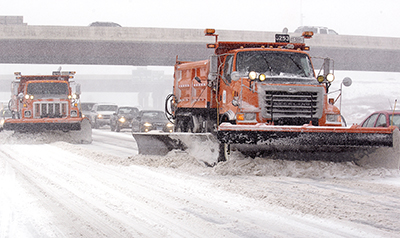This project sought to identify effective performance metrics for snow and ice maintenance operations. Winter storms present many challenges to transportation agencies, the foremost being meeting ever-increasing public expectations with limited funding for personnel, equipment, materials, contract assistance, and other resources. Therefore, agencies must find practical and relatively inexpensive means to increase the efficiency and effectiveness of their winter operations. To do that, they must have objective, realistic performance measures—including established level of service guidelines—as well as ways to collect, compile, and analyze the pertinent data.
To determine effective performance metrics, researchers gathered information from published literature. They also surveyed all possible snow and ice states to gather information about their use of performance measures. The survey results were tabulated and analyzed to identify commonalities and differences among agencies and to develop a matrix of performance measures. Relative costs of gathering and analyzing the performance data and methods of communicating the level of success inside the organization and beyond were also presented.
The project team was led by researchers at Washington State University on behalf of Clear Roads, an ongoing pooled fund research effort focused on winter maintenance materials, equipment, and methods. Clear Roads research projects are managed and administered by the Minnesota Department of Transportation (MnDOT).
The research team organized performance measurement techniques according to (1) method and cost and (2) timeliness, effectiveness, and reliability. The resulting matrix indicated that transportation agencies’ primary goal for snow and ice control is to sufficiently restore safety and mobility to highways, roads, and streets within acceptable time frames.
Agencies indicated that their most important performance goal is safety, followed by mobility, economy, essential functions, environment, infrastructure, and livability. In addition to safety and mobility, achieving an established level of service (LOS) is also a high priority for all agencies. The top three LOS criteria considered for snow/ice control are maintaining roads that are safe and passable throughout a storm, providing bare pavement as soon as possible, and setting service by traffic volumes.
The survey revealed an increased use of outcome-based measures, such as a friction-based metric. This trend is likely a result of the rising importance of customer satisfaction and the increased demand for agencies’ transparency to the public. Many agencies also showed strong interest in the severity index-based performance metric, as it allows more accurate comparisons among storms and among seasons, which are useful for long-range budgeting and planning. The cost-method matrix and the timeliness-reliability-effectiveness analysis also showed that most of outcome-based measures have relatively high reliability and timeliness.
The researchers concluded that for agencies at all levels, performance metrics are generally safe and efficacious for improving winter operations. These metrics can also facilitate communication and engagement between the public and transportation agencies, which in turn can lead to a more transparent and effective programs for snow/ice removal.
Authors:
Gang Xu
Xianming Shi
WSU Department of Civil and Environmental Engineering
Leigh Sturges
Mike Chapman
Chris Albrecht
The Narwhal Group
Dave Bergner
Monte Vista Associates, LLC
Sponsors:
Minnesota Department of Transportation
Clear Roads Pooled Fund

